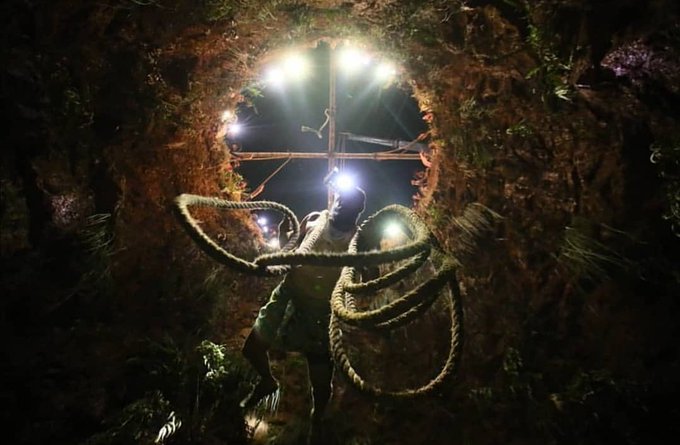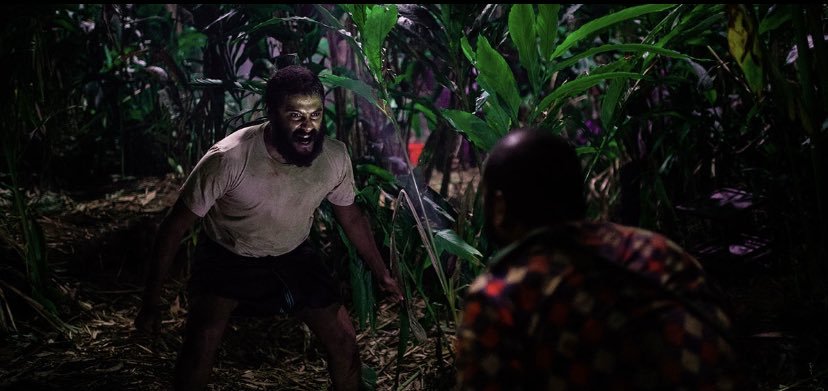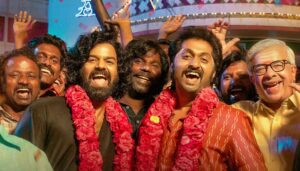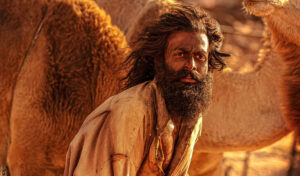
If there’s a genre called ‘non-vegetarian cinema’, Malayalam filmmaker Lijo Jose Pellissery possesses all merits to own that space. After serving us pork in his smashing crime caper Angamaly Diaries in 2017, the director is back in 2019 with a story around buffalo meat, or rather a buffalo which had a narrow escape from filling up the plates – much to an entire village’s dismay. Clearly, these films are not easily digestible for vegetarians – a sensation that I derived from one of my favourite films of the decade, On Body and Soul directed by Ildikó Enyedi. That said, Pellissery’s fascination for meat is no deterrent in making us dive into his latest feature Jallikattu which packs a rousing narrative in 90-odd minutes
Set somewhere in Kerala’s hillier terrains, the setting of a buffalo gone astray bears shades of Pellissery’s earlier ventures. The story-line does not concentrate on a singular theme but have a series of them stacked together in harmony – each infusing some kind of life into another. There is the butcher Antony (Antony Varghese, exuding raw, vigorous power) who is unaffected by the chaos that ensues. There are the authorities who parade the village trumpeting about the possible animal menace. There’s the father of a soon-to-be-engaged girl who is worried about the menu that is to contain good quality beef. The girl herself has certain plans to execute. This way, Pellissery captures the everydayness of an ordinary Kerala village with stupendous flair as he works around a screenplay (based on Maoist by S. Hareesh) that keeps you on the edge of your seats.
Shot by Ganesh Gangadharan, Jallikattu is a visually overpowering feature. Besides the symbolic buffalo on the run, it is the motion in the frames that lends atmosphere to Pellissery’s film. The key story elements, decidedly, are too many in number. You blink an eye and a detail stands missed. Ditto for the frame transitions which – in true LJP style – are swift, unless the order of the day was to focus on lengthy, captivating long takes. This, coupled with several recurring elements from the filmmaker’s own reserve, reminds us that his cinema is slowly (or rather discernibly) developing a strong auteurial flavour.

Jallikattu, especially, is not people-centric. Nor does it focus on an issue pertinent in its surroundings. It is when the film turns into a raw portrait of existentialism at the outset of an adversity that it magically takes off. I couldn’t stop chuckling at the sight of the local housewives boiling tapioca while chiding off a man who warns them about the wandering buffalo. It was funnier to see a man blackmail the officer in a local bank to write off his mortgaged property. These are classic, incessantly localized tones in the screenplay (S. Hareesh, R. Jayakumar) that would not have made as much sense in, say, another geography or amid a different cultural stratum.
Talking about the tone of the film which exposes several of Kerala’s indigenous tendencies, Jallikattu strongly addresses the migration that took place post-independence – an arrangement encouraged by religious and political patrons. People, especially those without great means of living, moved from the state’s more affluent corners to Malabar and other adjoining areas. Such stories have always been enthralling – be it as chronicled in some of Malayalam’s rich literature or transferred verbally from the forefathers. The latter gets a brief window in Pellissery’s film, making us ponder why human invasion, afforestation and the ascent of the so-called development trajectory has cultivated certain skewed morals which make us insensitive to the needs of the nature. The angry buffalo, at no point, comes across as a villain. For a fact, the scenario is all about human beings invading space that rightfully belongs to animals. The fertile soil richly held together trees and shrubs which, on this date, necessitate to be shielded from animal invasion – which is a massive irony if we think about it. In Jallikattu, even the stream flows with a violent temper. The nature displays its anger by pouring incessantly at the wrong hour.
There is more to the localized elements in Pellissery’s writing which can be seen in the way he intersperses humour in his story. We are shown a paan-chewing letter writer who, in the complaint to the district collector, chooses to call the buffalo a ‘Mahisham’ – a more formal word for the animal from the Malayalam dictionary. The film also addresses the organic co-existence of local Keralites with migrant workers from Bangladesh, West Bengal and other North Indian states by gracefully placing a character of the ilk among the commotion that ensues. There is also a ‘Bombay Mittai’ street vendor whose hand cart with a bell provokes the raging buffalo. At a later point, somewhere in the background, we also observe how the local folks help him out to put his moving business back in place. In a personal favourite passage from the film, a fantastic Jaffer Idukki (as the stingy Kuriachan) is seen reveling about the menu that he envisages for the upcoming family function.
ALSO READ: ‘Bhayanakam’ review – an anti-war masterpiece high on implied violence
On that note, it is in the more dramatic segments that Jallikattu falls slightly short in comparison. The central row between Antony and Kuttachan (Sabumon Abdusamad), which frequently breaks into flashbacks, is neatly knitted onto the larger canvas but is not entirely exciting. The track involving the neighborhood girl (Santhy Balachandran) is, again, half-baked with her final scene appearing quite bizarre when the character’s nonchalance backfires. The abusive police inspector with certain marital issues is merely an extreme version of a similar character in Khalid Rahman’s critically acclaimed Unda.
Jallikattu – as is the case with the filmmaker’s earlier films Ea.Ma.Yau and Angamaly Diaries – is about a horde of angry men. The endless movement of the camera as well as the torch lights seen all across the dense, hilly landscape become scary reminders of the imminent terror with which Pellissery slowly warms us up to the finale. However, as much as I buy the thought process and the obvious metaphor involved, the climax of Jallikattu largely misses the brilliance of the narrative thus far. As cinematic devices, the visuals and the mounting are indeed powerful but if we attempt to equate it to the film’s overall temperament, the sudden tonal shift siding to realms of surrealism just about passes muster.
That aside, Jallikattu distinctly proves how Lijo Jose Pellissery has mastered the technique to illustrate the Malayali Christian way of life to a T. Right from the diet to the dialect (which is a mix of local and migrant influences), the film spontaneously transports us to a society that is handsomely in sync with its inborn lifestyle. We also need to address the way the characters find definitive graphs and textures, atypical of the filmmaker’s oeuvre. Unsurprisingly with a theme such as this in the order, Jallikattu is high on testosterone. This makes me wonder when whether Pellissery will ever finitely explore the female psyche. After all, his erstwhile films featured a handful of life-like women protagonists – be it Amen’s feisty Shoshanna, Angamaly Diaries’ commanding Lichi or even a couple of them in Ea.Ma.Yau. With all this badassery in place, I am tempted to say how Pellissery owes a kickass film to (and about) the womenfolk. How about a spin-off around the tapioca-slicing ladies in Jallikattu? Well, I am more than game.
Rating: ★★★★

